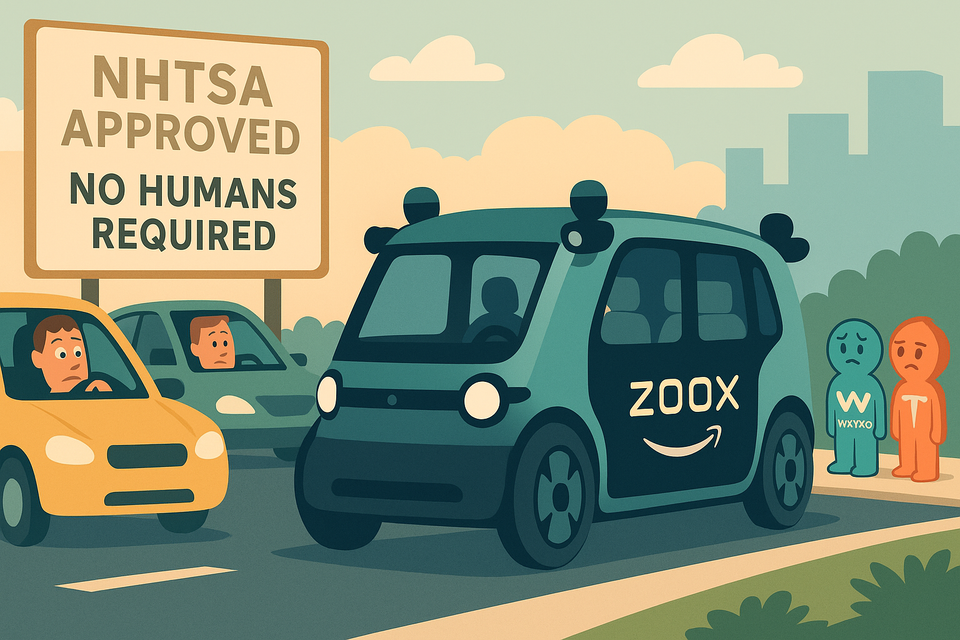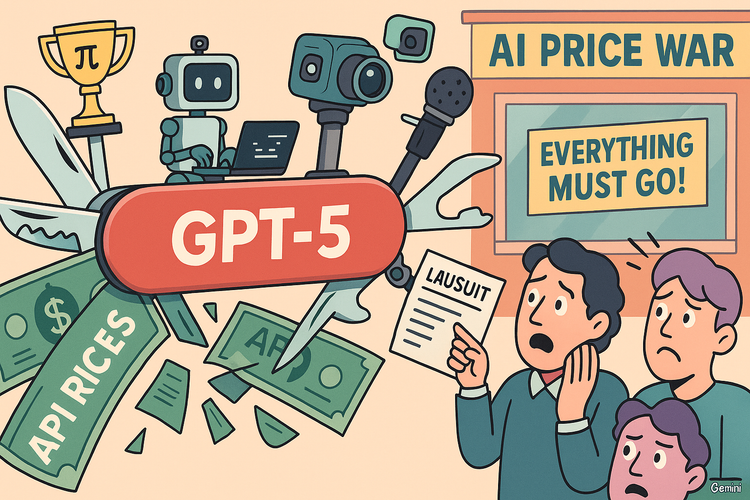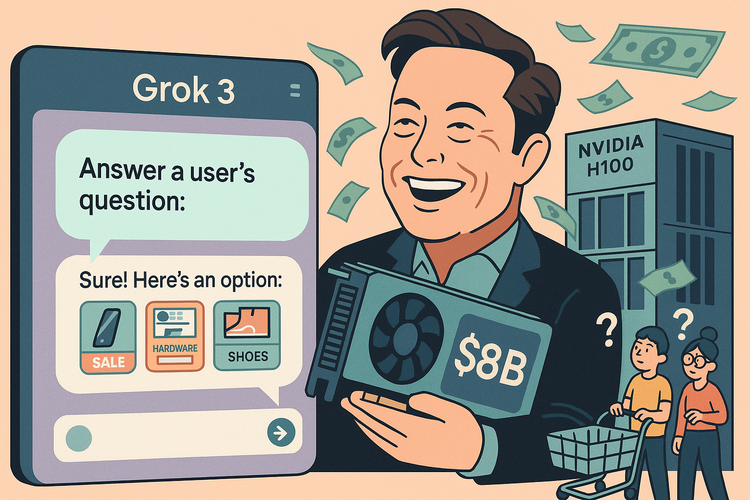Zoox Just Got the Green Light to Ditch the Steering Wheel. Here's Why That Actually Matters

Summary
Zoox just became the first U.S.-based company to receive federal exemption to operate robotaxis without a steering wheel or pedals. That’s not just cool—it’s regulatory history. Here's what that means for the future of autonomous vehicles, and why Waymo, Tesla, and Amazon all care deeply.
The First AV Without a Brake Pedal (Yes, Really)
On August 6, 2025, the U.S. National Highway Traffic Safety Administration (NHTSA) approved Zoox’s petition to test purpose-built robotaxis on public roads—vehicles with no steering wheels, no pedals, and no driver seats. It’s the first time a domestically built autonomous vehicle has been given that kind of freedom.
The approval comes under the newly expanded AV Exemption Program (AVEP), which lets qualifying autonomous vehicles bypass certain federal safety requirements—as long as they prove they can meet or exceed safety expectations through alternative means.
Translation: Zoox doesn’t have to pretend its car is a car.
Reinventing the Car From the Wheels In
Zoox’s vehicle looks less like a sedan and more like a symmetric tech pod. Think: four inward-facing seats like a subway car designed by Apple. It’s bi-directional, so there’s no need for U-turns, three-point turns, or even reverse gear. Each side is the front.
Key Specs:
| Feature | Spec/Detail |
|---|---|
| Max Speed | 75 mph (urban optimized at 45) |
| Battery | 133 kWh (16 hrs operation) |
| Sensor Suite | 6 LiDARs, multiple radar, camera, ultrasonic |
| Powertrain | Dual redundant |
| Braking System | Independent per wheel w/ diagnostics |
| Safety Logic | Auto-switch between uni/bi-directional mode |
So yeah. It’s built to never need a driver, and more importantly, it’s built to not pretend one exists.
The AV Landscape: A (Mostly) One-Way Race
Waymo: The Current King
Waymo’s still the leader in actual public robotaxi rides, offering over 250,000 paid rides monthly in cities like SF, LA, Austin, and Atlanta. Their cars still have pedals and steering wheels (for now), but they’ve logged over 20 million autonomous miles.
Tesla: The FSD Illusion
Tesla’s Full Self-Driving (FSD) is still in SAE Level 2-3 territory—meaning humans must stay alert. Elon says they’ll 10x parameters in the next version. Sure. Meanwhile, they still haven’t secured regulatory exemption for true driverless ops.
Cruise: Brakes On
After a high-profile pedestrian incident in San Francisco in 2023, Cruise hit the brakes. Regulators hit back harder. GM is now cutting funding, and the service is effectively paused.
Apple: Deleted
After ten years and billions spent, Apple quietly pulled the plug on its AV dreams in early 2024. Turns out building cars is hard. Who knew.
Baidu Apollo: Scaling Fast, Just Not Here
Apollo Go has completed 9 million+ rides in China and surpassed 1.1 million paid rides in Q4 2024 alone. Backed by generous local regulation, it's the only real large-scale robotaxi network in existence—but mostly confined to China (for now).
Zoox's Go-to-Market Strategy: One City at a Time
Zoox plans to launch its commercial service in Las Vegas by late 2025, followed by San Francisco. It already runs internal testing in SoMa and has deals with AREA15 and Resorts World Vegas for pickup zones.
Its Hayward, CA factory—opened in June—is cranking out one robotaxi a day with expansion capacity to 10,000/year. That’s the first purpose-built AV factory in the U.S.
In each city, Zoox plans to deploy 500–1,000 vehicles, targeting dense, urban geographies where symmetrical design pays off. No more awkward U-turns downtown.
Amazon's Angle: Logistics, but Later
Amazon owns Zoox. But for now, the robotaxis aren’t delivering packages. Yet.
Zoox is run as an independent subsidiary, with focus strictly on ride-hailing. Still, analysts project Amazon could save up to $2B annually in logistics if and when Zoox is integrated into last-mile fulfillment. Think: Prime, but with no driver.
Some whisper that Zoox may one day be bundled into Prime membership like Prime Video or Music. For now, Zoox’s execs are saying: Not yet. First, people.
The Regulatory Breakthrough That Made It Possible
NHTSA’s new AV STEP program is a two-tiered regulatory model:
- Tier 1: Vehicles requiring human supervision.
- Tier 2: Fully driverless vehicles (like Zoox).
Companies must submit extensive safety cases, verified by independent assessors. Zoox’s approval marked the first U.S.-built vehicle to receive Tier 2 exemption.
States still control deployment and licensing. For now, California, Nevada, Arizona, and Texas are the friendliest AV territories.
The Market Outlook: Explosive, Maybe
According to Goldman Sachs:
- U.S. robotaxi market = $7B by 2030 (35K vehicles, 8% of ride-hailing)
- Global AV market = $43.76B by 2030, growing 73.5% CAGR from 2025
- U.S. AV workforce = 567K jobs in 2025 (+52K this year alone)
Zoox, backed by Amazon and now federally cleared, is well positioned to ride this wave—if it can scale and earn public trust.
The Obstacles
- Cost: Robotaxis are still expensive to build. Cheaper than Uber drivers by 2030? Maybe.
- Public trust: Most people are still spooked by driverless cars.
- Scaling: Building and deploying 10,000 custom vehicles is hard.
And let’s not forget, the biggest competitor to Zoox might not be Waymo, but… inertia. People still like driving. Or at least, being driven by people.
Final Thought: We Finally Built the Car of the Future. Now What?
Zoox is no longer just a sleek demo vehicle in a TED Talk. It’s federally legal. It’s manufacturing-ready. It has a roadmap, a rollout, and maybe a shot at defining what post-driver transportation looks like.
Will it work? Maybe.
But at least now, they’re allowed to try.
Want more like this? Subscribe to TrendFoundry for exclusive insights into the future of autonomy, AI, and what it all means for real people.
Sources
- U.S. DOT – NHTSA AV STEP official page
- AP News – Zoox aims to build 10,000 robotaxis annually
- Business Insider – Inside Zoox’s Hayward robotaxi factory
- Goldman Sachs – Robotaxi market forecast to 2030
- AP News – Waymo expands robotaxi service with Uber in Atlanta
- Reuters – Zoox gets historic NHTSA exemption
- Financial Times – Challenges in global robotaxi rollout
- Zoox – Official technology and vehicle overview



